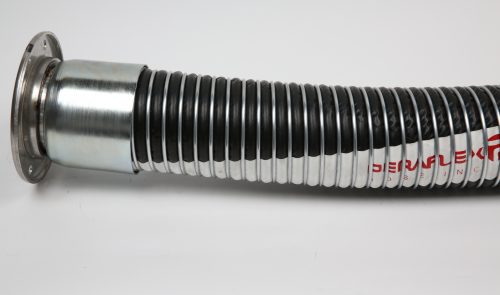BL-GGP & BL-AAP – BOTTOM LOADING

Peraflex Bottom Loading Hoses BL-GGP and BL-AAP are constructed for optimal reliability and safety. In addition to the seamless tubular design, these hoses are double grounded, include an abrasion and fire resistant cover, and fire resistant interior. Lightweight and easy to handle, these hoes are ideal when transferring hydrocarbons and high aromatic products.
Typical Conveyance
Gasoline, diesel fuel, 100% aromatics, MTBE, paraffin and kerosene
**Refer to chemical compatibility chart for specific recommendations**
SPECIFICATIONS
Peraflex Type BL-GGP:
Black With White Stripe
G – Galvanized Internal Wire
G – Galvanized External Wire
P – Polypropylene Tubes
Green With Black Stripe
A – Aluminum Internal Wire
A – Aluminum External Wire
P – Polypropylene Seamless Tubes
Construction
Cover – Vinyl coated polyester. Abrasion, ozone and fire resistant
Fire Barrier – Fiberglass tightly-woven fabric
Reinforcement – High strength, High-density polyethylene woven fabric
Liquid Barrier – Seamless polypropylene tubes and film barriers
Options – Custom colors, special branding and high strength ballistic nylon cover
Applications:
- Refineries
- Distribution Terminals
- All Loading Arm Applications
Specifications:
- Temperature range: -40°F to +212°F
- Full vacuum rated
- Safety ratio: 5 to 1 with factory crimped ends
- Electrically continuous
- Elongation: 6-7% @ maximum working pressure
BL-GGP
Part #
6BL-GGP400
I.D
(in.)
4
O.D
(in.)
4.7
Working Pressure
(PSI)
200
Bend Radius
(in.)
6.5
Weight
(lbs/ft)
3.4
BL-AAP
Part #
BL-AAP400
I.D
(in.)
4
O.D
(in.)
4.7
Working Pressure
(PSI)
200
Bend Radius
(in.)
6.5
Weight
(lbs/ft)
2.5
**Larger diameter hose available upon request**
End Fittings
Externally crimped NPT, fixed/floating flanges, quick disconnects and victaulic ends
All fittings are available in a variety of materials
Additional Information
Rated working pressure is @ 70°F
Increased operating temperatures may limit working pressure of the assembly
Technical data is approximate and subject to change.
Never exceed stated working pressures